Fifty years of heli-skiing
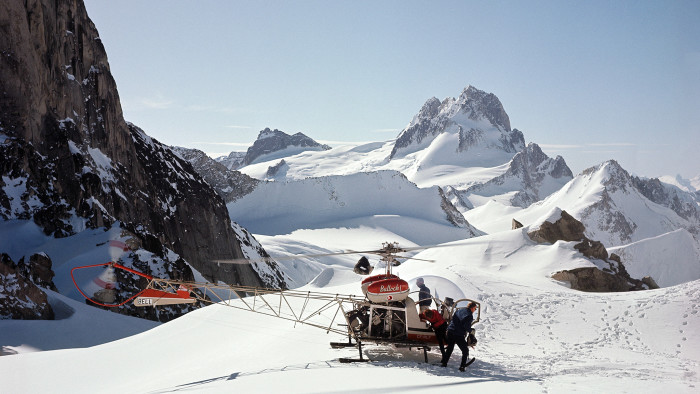
Simply sign up to the Life & Arts myFT Digest -- delivered directly to your inbox.
It is dark when we turn alongside the Columbia river and already the day is 26 hours old. We had left London at lunchtime, flown to Calgary and on to Kelowna, wound our watches back eight hours, then picked up a huge 4x4 and begun driving north. The river marks the start of the final stretch, a 90-mile dead-end road that is covered in snow and bordered by forest.
The temperature gauge on the dashboard drops to -15C. It’s silent but for the splatter of snow on the underside of the car; the radio gave up its search for stations long ago. Once, we have to slam on the brakes as a deer leaps into our path, then again when a motionless moose suddenly looms in the headlights.
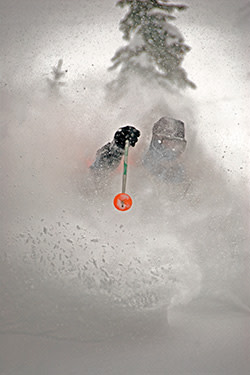
The story of the development of ski tourism might begin in the aristocratic surroundings of St Moritz in 1864 but the trail ultimately leads here, to a lonely logging road in a remote corner of British Columbia. Exactly 100 years after the first winter tourists set out for St Moritz, an Austrian guide on the other side of the world was preparing to take skiing into the jet age. And while the pioneers in St Moritz were drawn by the prospect of high jinks and high-powered socialising – of toboggan races and pony rides on the frozen lake, followed by grand dinners back at the Kulm Hotel – the Austrian and his adventure-hungry acolytes in Canada were driven by an entirely opposite motivation: the desire to escape into the wilderness.
The guide’s name was Hans Gmoser. Fleeing the deprivations of postwar Europe, the 19-year-old Gmoser had emigrated in 1951, finding work as an electrician before eventually becoming one of Canada’s best-known climbers, skiers and guides. By the mid-1960s, ski resorts were booming – in 1964 work began on Whistler, a new purpose-built resort that would become the biggest in North America – but already Gmoser was feeling the call of the wild. In 1965 he gave a speech to the Canadian Ski Instructors’ Alliance extolling the virtues of ski touring: exploring beyond the busy resorts and accessing new terrain by walking uphill on skis rather than using lifts.
“In addition to the somewhat frivolous thrill of dancing down the hill, [the ski tourer] also seeks the aesthetic values inherent in the mountain country to which the ordinary skier is completely oblivious,” he enthused. “Ski touring takes us on to those mountains and slopes which we always look at from the top of our lifts and wish we were over there instead of here. It gives us the means to manifest our, however hidden and subconscious, desires to explore the distant, the new, the unknown, to be adventurers, to be able to throw back the shackles of our physical limitations and to go wherever our fancy urges us to go . . . ”
It was stirring stuff but there was more to come. For Gmoser was developing a new type of ski touring, in which the hard slog uphill would be removed by technology. “For uphill transportation for ski touring we need something with far more versatility and mobility than the most convenient types of ski lifts,” he told the instructors. “The machine to fit the bill is a helicopter.”
Finally, after six hours on the road, we emerge from the forests to see light streaming from the windows of a large building that’s strangely reminiscent of both an alpine chalet and an airport terminal. Inside, people are sitting at a long bar, playing cards by the fireplace and table-tennis in an adjacent games room. Having not even passed another car in the previous two hours, the sudden warmth, light and human contact are disorientating.
This is Monashee Lodge, the world’s largest heliski lodge and the newest in the portfolio of Canadian Mountain Holidays (CMH), the company Gmoser founded. The lodge offers every comfort: there is a hot tub on the roof, a team of masseuses, a large wine cellar, a climbing wall, ski shop, business centre, library and 69 bedrooms. Guests are looked after by seven guides and 26 staff. It is a huge, five-star example of how far heli-skiing has come.
Today the sport Gmoser pioneered in 1965 has spread around the world: heli-ski operations have sprung up in far-flung mountain ranges from Alaska to India, in Chile, Turkey, Georgia, Sweden, Iceland and many other countries. CMH, though, remains by far the biggest operator, employing at least 120 mountain guides at its 11 bases in British Columbia.
Gmoser had begun experimenting with helicopters to access the mountains in the early 1960s but the first commercial “helicopter ski touring” trips (the word “heli-ski” had yet to catch on) took place over two weeks in April 1965. If our journey felt long, it was nothing to that of those first heliskiers, who reached the last section of road to their camp at 5pm but took nine more hours to cover the final 28 miles (“numerous times we were stuck in the mud, got rained upon and pushed the vehicles,” Gmoser later wrote). Accommodation was basic: the guests (six the first week, 12 the next, each paying $275) stayed in the plywood cabins of a disused sawmill camp, sleeping on iron beds in their sleeping bags. The guides, cook, pilot and mechanic slept on the floor of the kitchen building.
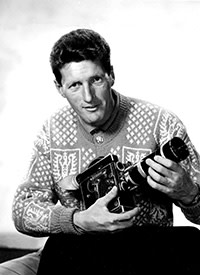
In the morning, the helicopter would begin to ferry the skiers up the mountain, a lengthy task given that this was a slow, piston-engined Bell 47, which could only carry the pilot and two passengers. Women were taken last, to minimise their time waiting in the wind on the freezing mountainside. Each day they would make just one or two runs, often having to bushwhack back through the forest to camp, where they would gather in the kitchen to sing, play the instruments they had brought, drink and stay warm until going to bed at 10pm.
Halfway through the second week, the helicopter crashed. It was coming in to land when the landing gear sank into deep snow, causing a rotor to strike the ground. The three people on board managed to jump out before it burst into flames; all were shaken but unharmed, and the pilot was quickly dispatched to find a replacement machine to finish the week. But the risks and hardships of that first fortnight were matched by the thrill of discovery – of unskied slopes and a new way of reaching them. The first heliskiers went home, told their friends about their adventure, and Gmoser’s company never looked back.
. . .
Half a century later, we crouch down beside the lake in front of the lodge and wait for our lift. It is -20C, cold enough to make steam rise from the water; a family of bald eagles swoops in and out of trees by the shore. Then, a low rhythmic thud carried on the wind, oddly familiar from countless Vietnam war movies; it grows louder as the helicopter approaches.
The flimsy three-seaters used in the early days have long gone; this is a twin jet engine Bell 212, which will easily swallow our group of 10, as well as the guide and pilot. There’s a surge of adrenalin as it eases down from the sky, rotors furiously beating the air, skids just feet from our huddled group, its belly close enough that I can see every rivet. The guide slides back the door and we clamber in, rushing and struggling to strap safety belts over our bulky clothes. Then the helicopter gently lifts and turns, crossing the misty lake and climbing the steep, forested slope on the far side.
Coming in as an outsider, CMH feels like a tight-knit club, if not quite a cult. The other skiers in my group – indeed 90 per cent of those in the lodge – are indistinguishable thanks to their brightly coloured Gore-Tex skiwear, all of it branded with the CMH logo. Most of them have been coming for years, if not decades, often moving between different CMH lodges before settling on a favourite.
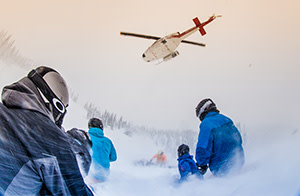
In part their loyalty is due to a gimmick introduced in the early 1970s. Each night, the vertical distance each client has skied that day is posted on a board in the lodge, along with their cumulated lifetime total. Perhaps it’s something to do with the alpha-personality types who go in for this kind of holiday, and who can afford it, but in the CMH club, people really seem to take pride in this (utterly meaningless) figure, a badge of how much virgin snow they have defiled. Those who hit a million vertical feet are awarded a special CMH ski suit, presented after dinner in the lodge. My total after four days was just over 80,000ft; the frontrunner in the lodge that week had notched up a lifetime total over 26 million (he is so in thrall to the experience that he keeps a room at the lodge for the entire season).
It would be easy to mock – to bemoan how the original motivation of exploration and escape has been replaced by one of consumption and competition – were the whole thing not done in such warm North American spirit. The special suits are awarded in a sort of gang show (think shaving foam and dressing-up) designed to humiliate as much as honour the recipient. Dinner is eaten around large communal tables – a concept that ordinarily strikes terror into my English heart but which is a delight here thanks to the friendliness of the mostly US guests and the club-like atmosphere that prevails. After dinner and at the bar, people stand up to tell jokes and shaggy-dog stories that have been passed down between generations of guides and guests. Some of the punchlines might have been lost along the way but it’s hard not to be charmed. By the second night, everyone seemed to know my name.
. . .
This winter there will be numerous events to mark the 50th anniversary of the sport Gmoser created, including several “nostalgia weeks”, but the connection with the past seems to run strong through the whole operation. Despite the delights of the new lodge, many of those I talk to like to remember the early days before its construction, when they stayed in a basic hostel used by workers building a nearby hydroelectric dam. They recall leaking roofs and lumberjacks swinging punches – even the day the hostel caught fire is a topic for nostalgia, as is another helicopter crash. “The machine was on its side and filling up with fuel – I thought I was a dead . . . ” one man tells me with a grin. Didn’t that put him off? “Well it was the final week of the season anyway but I was back the next year.”
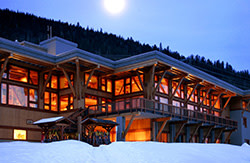
Perhaps this is the key: despite the luxury and the special suits, this remains a genuine adventure. In all, 42 people have died skiing with CMH, the most recent being last winter. Given the size of the operation, it’s not a surprising figure – it represents approximately one death per 31,000 skier days – but the presence of risk, no matter how small the chance of being involved, changes the atmosphere, making everything more vivid. Safety briefings are taken seriously, guides are respected, guests build stronger bonds, après-ski is more celebratory.
And whether it’s a club or a cult, it’s one with a total commitment to a single central tenet, one that remains the same now as it was in 1965. Our helicopter lands at the top of a run called Nagel East, touching down in a clearing surrounded by blackened tree trunks, the survivors of a past forest fire. We jump out, huddle together once more as our guide unloads the skis, then watch as the helicopter peels away off the mountainside to get the next group, its frantic noise replaced by a crescendo of silence.
The guide leads and we follow in line, traversing at first, poling hard to get moving in the deep snow, passing through a glade of skeletal trees, before regrouping where the mountainside starts to fall away. The guide gives a list of safety instructions, then one by one we push off.
The skis accelerate rapidly and then, like a speedboat starting to plane, rise up and come alive, floating through the thigh-deep snow. Powder like this can be more than 90 per cent air – less dense than the froth of a cappuccino – and it is the only thing supporting me against gravity’s pull. I plunge downwards, weaving between the black trunks that are the only solid, vertical reference points in a mad world tipped on its side and awash with rushing snow and plummeting skiers. Some turns send up white waves that cover my face. The feeling is somewhere between falling and flying, a delicious mania found at the outer limit of control.
This is skiing’s “rapture of the deep” – potentially dangerous because it is so all-consuming, calling skiers to go faster, to abandon restraint, do anything to prolong the sensation. But it is wonderful too, the club’s motivation and lifeblood, the ephemeral commodity that has sustained CMH for 50 years and built an industry, the siren call that draws people across the world and up long logging roads in the darkness.
Tom Robbins was a guest of Pure Powder (purepowder.com) and Air Canada (aircanada.com). Pure Powder, a specialist heli-ski tour operator and CMH’s UK agent, offers a week’s trip with CMH from CAD$11,500 (£6,329). Air Canada has daily flights from London to Kelowna, via Calgary, from £825
Photographs: Topher Donahue; Juergen Klecha; Alex O’Brien
Comments